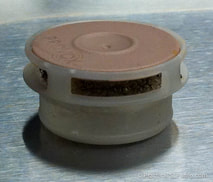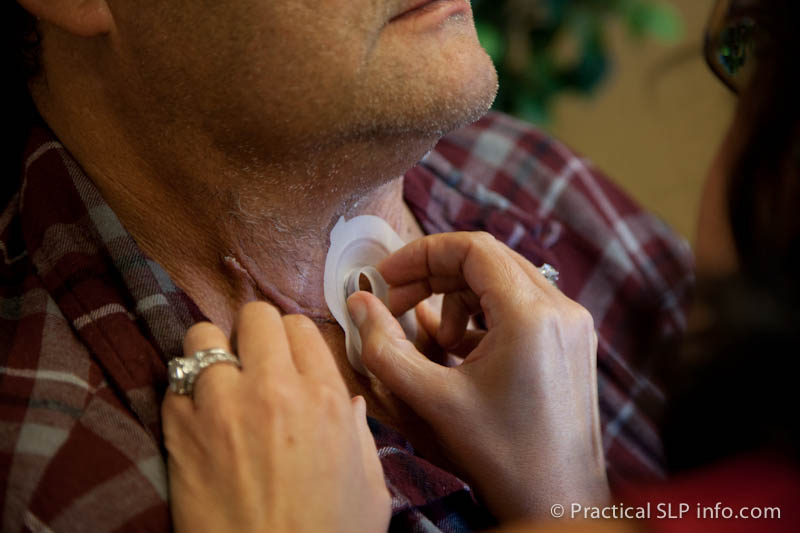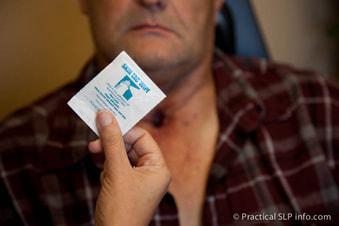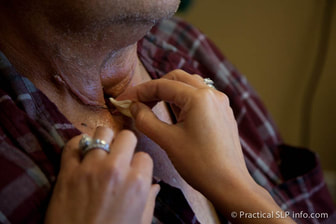How often and when do I use an HME?
In order to be of maximum benefit, the HME should be worn 24 hours per day, every day of the week. During periods of increased physician activity, should you notice a sense of restricted breathing, remove the device until respiration becomes more comfortable. This should only be done for more emergent cases. For regular increased physical activity, the speech pathology staff can help select the most appropriate HME for use which would (hopefully) allow for continued utilization, even during these periods of increased respiratory demands.
How often do I replace my HME cassette?The HME cassette needs to be replaced every 24 hours. It is never ok to use these beyond the 24 hour device lifetime, nor is it appropriate to attempt to wash the HME. These should also never be run under water or immersed in water as this will wash out the salt (an antimicrobial component) that is essential for the HME functionality. Even though the HME cassette is treated with salt (an agent that might prevent bacterial growth), after 24 hours the cassette needs to be replaced to ensure it does not begin to develop bacterial colonies. |
Why do I need to change my HME cassette every 24 hours?
Although the salt in the HME cassette is an antimicrobial agent, there is always a risk that there will begin to develop bacterial colonies.
How often do i need to replace my
HMe Housing?
|
Unlike the HME cassette which must be changed every 24 hours, an HME housing can be worn as long as the adhesive seal is functional. If using a TEP, this means changing the adhesive housing when excessive air leaks are noted. If not using a TEP, the housing should be changed when there is no longer a sufficient seal against the skin.
|
How long an adhesive housing lasts varies from person to person and is dependent on several factors. For tips on improving the length of use per housing, see How to Apply an Adhesive Housing.
When I push down on my HME cassette,
why do I get air leakage?
First, it is important to be sure the air leakage is not coming from the adhesive housing or Larybutton. If a good seal is demonstrated, it is very likely the finger closure of the device is not sufficient to completely shut down the passage of air. It is important to remember that air will always travel through the path of least resistance. The prosthesis lumen or channel, is quite small in relation to the windpipe and therefor, airflow will be more resistant to going through it instead of an open stoma. If the HME faceplate is not entirely compressed against the base of the HME, air will leak. There is a small circular impression at the center of the Xtra HMEs. Pressing in the center of the cassette, where the impression is made on the HME should work to prevent air leakage during speech. If this does not improve, the speech pathology staff can assist you with preventing this.
How can I improve the seal of my
adhesive housing?
Be sure to follow the steps detailed in How to Apply an Adhesive Housing.
Some helpful hints:
- Use one hand to stretch the skin around the stoma to be as smooth as possible, while using the other hand to apply the adhesive.
- Apply the bottom of the ring first, aligning with the bottom of the stoma. This will help with achieving the best alignment here.
- Press the ring solidly to the skin before allowing the adhesive to really settle of the skin.
- Use a fingernail to seal around the edges of the ring, then move outward, careful to smooth out any creases or bubbles in the adhesive.
- Stretch any loose or creased skin so that it is as smooth as possible below the adhesive as you work your way around.
- Use your fingernail to press the adhesive into any deep creases or seams in the skin.
- Warming the adhesive housing first, either holding against the torso for a few minutes or using a blow-dryer on low can also help ensure a good seal.
- Allow 30 minutes after applying the adhesive, before speaking.
- Some patients find the use of medical grade silicone glue helps to improve the adhesive seal (Not advised if you are using OptiDerm).
AT FIRST, THIS CAN BE A FRUSTRATING EFFORT, BUT IT WILL GET EASIER THE MORE YOU DO IT. KEEP TRYING! SOON, IT WILL BE AS EASY AND NATURAL AS BRUSHING YOUR TEETH!
How can I make my adhesive last longer?
|
In some cases, patients may have one particular spot where the adhesive seal breaks down first. If the remainder of the adhesive is still very good, it may be possible to apply pressure to the leak with your finger when speaking. This can help prolong improve the quality of your speech as well prolong the time between adhesive housing changes.
Some other helpful hints:
|
Applying Glue to Improve the Adhesive Seal.
See How To Apply An Adhesive Housing. |
Is it ok to wear my adhesive and HME during hyperbaric oxygen treatments?
There is no contraindication for wearing the adhesive housing or HME during hyperbaric oxygen treatments, although facility regulations may require you to remove it during your treatment.
Why is my Larybutton leaking air?
It is important that the Larybutton be well situated against the stomal wall with a bit of a snug fit. In some cases, the pressure applied to the wall of the stoma when achieving the snug fit may cause the stoma to dilate over time. Just as the stoma may dilate, it can also return to its original size. In this case, the SLP staff can assist you in managing a better fit, often times using an alternate HME housing to allow the stoma to return to its previous size.
There can also be changes to the shape, size and/or angle of the stoma as time progresses. This can be from continued healing, normal aging or a variety of other causes. The SLP staff can determine what you are best suited to use in these cases.





